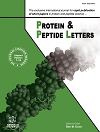- Home
- A-Z Publications
- Protein and Peptide Letters
- Previous Issues
- Volume 22, Issue 10, 2015
Protein and Peptide Letters - Volume 22, Issue 10, 2015
Volume 22, Issue 10, 2015
-
-
Organophosphorus Inhibition and Characterization of Recombinant Guinea Pig Acetylcholinesterase
More LessOrganophosphorus (OP) pesticides and nerve agents have been designed to inhibit the hydrolysis of the neurotransmitter acetylcholine by covalently binding to the active site serine of acetylcholinesterase while Alzheimer drugs and prophylactics, such as tacrine, are characterized by reversible binding. Historically, the guinea pig has been believed to be the best non-primate model for OP toxicology and medical counte Read More
-
-
-
Humanin Peptide Binds to Insulin-Like Growth Factor-Binding Protein 3 (IGFBP3) and Regulates Its Interaction with Importin-β
More LessAuthors: Evert Njomen, Hedeel G. Evans, Samanthi H. Gedara and Deborah L. HeylNuclear translocation of IGFBP3 by importin-β1 is a prerequisite for IGFBP3-induced apoptosis. The neuroprotective peptide humanin (HN) counteracts IGFBP3-induced cell death. However, the mechanism by which humanin protects cells is currently unknown. The natural synthesis of this peptide decreases with age, coincident with the likelihood for the development of Alzheimer’s Disease, making it a promising target Read More
-
-
-
Efficient Purification of rhG-CSF and its PEGylated Forms and Evaluation for In Vitro Activities
More LessGranulocyte-colony stimulating factor (G-CSF) has commonly been used to help the patients to recover from neutropenia inflicted due to radiotherapy, organ transplants and chemotherapy. As the number of people undergoing these therapies and procedures are increasing world-wide, the need for more economical ways of G-CSF production and improvement in its efficacy has become increasingly crucial. In the p Read More
-
-
-
The Use of Affinity Tags to Overcome Obstacles in Recombinant Protein Expression and Purification
More LessAuthors: Chinthaka Amarasinghe and Jian-Ping JinResearch and industrial demands for recombinant proteins continue to increase over time for their broad applications in structural and functional studies and as therapeutic agents. These applications often require large quantities of recombinant protein at desirable purity, which highlights the importance of developing and improving production approaches that provide high level expression and readily achievable purity of reco Read More
-
-
-
A Trypsin Inhibitor from Clitoria fairchildiana Cotyledons is Active Against Digestive Enzymes of Aedes aegypti Larvae
More LessAedes aegypti, the principal mosquito vector of yellow fever, dengue fever and chikungunya fever virus-transmitted diseases, is an insect closely associated with humans and their housing habitats. As there is no commercially available vaccine, prevention is the most suggested form of avoiding disease spreading and a number of studies are being developed in order to give support to vector control operations. The pres Read More
-
-
-
Understanding the Dual Inhibition of COX-2 and Carbonic Anhydrase-II by Celecoxib and CG100649 Using Density Functional Theory Calculations and other Molecular Modelling Approaches
More LessAuthors: Omkar Singh, Kumar R. Kakularam, Pallu Reddanna and Polamarasetty AparoyRecent developments in the dual inhibition studies of cyclooxygenase-2 (COX-2) and carbonic anhydrase (CA-II) imply a promising platform for the development of new generations of nonsteroidal anti-inflammatory drugs (NSAIDs). CG100649 is such a molecule that got recently approved by Korean Ministry of Food and Drug safety (MFDS) and is being marketed by the name polmacoxib for the treatment of osteoarthritis. CG1 Read More
-
-
-
Synthesis of New Peptide Derivatives of Galanthamine Designed for Prevention and Treatment of Alzheimer’s Disease
More LessNew derivatives of galanthamine containing peptide fragments with β-secretase inhibitor activity were synthesized. In position 6 of the galanthamine new shortened analogues of β-secretase inhibitor OM 99-2 (Boc-Val-Asn-Leu-Ala-OH and Boc-Val-Asn-Leu-Ala-Val-OH) were included. The new derivatives of the galanthamine in position 11 including Boc and norgalanthamine in P3 or P4 positions, Val in P2’ position and b Read More
-
-
-
Modeling proteins as residue interaction networks
More LessAuthors: Rajdeep K. Grewal and Soumen RoyProteins are the ultimate carriers of information encoded within genes. The salient feature of proteins is their ability to perform a vast array of function with extraordinary specificity. This specificity of proteins is related directly to their structural conformations, which arises as a result of complex interactions among its constituent amino acid residues. Thus, analyzing proteins through these interactions collectively is an ex Read More
-
-
-
Design of Phenylalanine-Containing Elastin-Derived Peptides Exhibiting Highly Potent Self-Assembling Capability
More LessAuthors: Iori Maeda, Suguru Taniguchi, Noriko Watanabe, Asako Inoue, Yuko Yamasaki and Takeru NoseIn this study, we developed a series of Phe-containing elastin-derived peptide-analogs, (Phe-Pro-Gly-Val-Gly)n (n = 1–5) and analyzed their reversible coacervation properties. Compared to the native elastin-derived repeating peptide sequence ((Val-Pro-Gly-Val-Gly)10M), one of the Phecontaining 5-mer repeating peptide sequences ((Phe-Pro-Gly-Val-Gly)5) clearly exhibited stronger coacervation properties. The coac Read More
-
-
-
In vitro synergistic effect of the CM11 antimicrobial peptide in combination with common antibiotics against clinical isolates of six species of multidrug-resistant pathogenic bacteria
More LessAuthors: Jafar Amani, Kamal A. Barjini, Mehrdad M. Moghaddam and Asadollah AsadiDuring the last decades, increase of antibiotic resistance among pathogenic bacteria has been considered as a global concern. Therefore, it is important to find new antimicrobial agents and/or therapeutic strategies. In previous studies we investigated antibacterial activity of the CM11 peptide against multiple drug resistant clinical isolates of six bacteria species including Pseudomonas aeruginosa, Staphylococcus aureu Read More
-
Volumes & issues
-
Volume 32 (2025)
-
Volume 31 (2024)
-
Volume 30 (2023)
-
Volume 29 (2022)
-
Volume 28 (2021)
-
Volume 27 (2020)
-
Volume 26 (2019)
-
Volume 25 (2018)
-
Volume 24 (2017)
-
Volume 23 (2016)
-
Volume 22 (2015)
-
Volume 21 (2014)
-
Volume 20 (2013)
-
Volume 19 (2012)
-
Volume 18 (2011)
-
Volume 17 (2010)
-
Volume 16 (2009)
-
Volume 15 (2008)
-
Volume 14 (2007)
-
Volume 13 (2006)
-
Volume 12 (2005)
-
Volume 11 (2004)
-
Volume 10 (2003)
-
Volume 9 (2002)
-
Volume 8 (2001)
Most Read This Month
Article
content/journals/ppl
Journal
10
5
false
en


